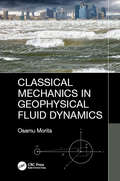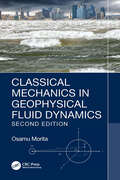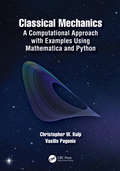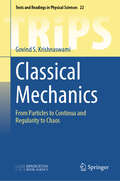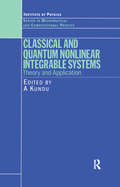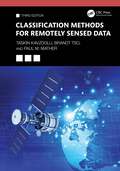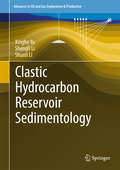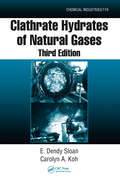- Table View
- List View
Classical Electrodynamics: From Image Charges to the Photon Mass and Magnetic Monopoles (Undergraduate Lecture Notes in Physics)
by Francesco LacavaThis book presents an overview of Classical Electrodynamics. Its second edition includes new chapters that pick up where the material from the first edition left off. The image method introduced in the first edition is expanded to series of images, using simple examples like a point charge or a charged wire between two grounded plates, as well as more relevant examples such as two charged conducting spheres and the force between them. The topic of complex functions is broadened with the introduction of conformal mapping. One new chapter introduces the method of separation of variables, including in Cartesian coordinates (box with sides at fixed voltages), in spherical coordinates (dielectric and conducting sphere, potential of a charged ring), in cylindrical coordinates (conducting wedge, cylinder in uniform field). It also presents the potentials and the fields for a point charge in motion, radiation by a point charge and by a dipole, radiation reaction. Two other chapters present updated lessons on the mass of the photon and search for monopoles. Examples and/or solvable problems are provided throughout.
Classical Field Theory
by Horaƫiu NăstaseClassical field theory predicts how physical fields interact with matter, and is a logical precursor to quantum field theory. This introduction focuses purely on modern classical field theory, helping graduates and researchers build an understanding of classical field theory methods before embarking on future studies in quantum field theory. It describes various classical methods for fields with negligible quantum effects, for instance electromagnetism and gravitational fields. It focuses on solutions that take advantage of classical field theory methods as opposed to applications or geometric properties. Other fields covered includes fermionic fields, scalar fields and Chern–Simons fields. Methods such as symmetries, global and local methods, Noether theorem and energy momentum tensor are also discussed, as well as important solutions of the classical equations, in particular soliton solutions.
Classical Field Theory: On Electrodynamics, Non-Abelian Gauge Theories and Gravitation (Graduate Texts in Physics)
by Florian ScheckThe book describes Maxwell's equations first in their integral, directly testable form, then moves on to their local formulation. The first two chapters cover all essential properties of Maxwell's equations, including their symmetries and their covariance in a modern notation. Chapter 3 is devoted to Maxwell theory as a classical field theory and to solutions of the wave equation. Chapter 4 deals with important applications of Maxwell theory. It includes topical subjects such as metamaterials with negative refraction index and solutions of Helmholtz' equation in paraxial approximation relevant for the description of laser beams. Chapter 5 describes non-Abelian gauge theories from a classical, geometric point of view, in analogy to Maxwell theory as a prototype, and culminates in an application to the U(2) theory relevant for electroweak interactions. The last chapter 6 gives a concise summary of semi-Riemannian geometry as the framework for the classical field theory of gravitation. The chapter concludes with a discussion of the Schwarzschild solution of Einstein's equations and the classical tests of general relativity (perihelion precession of Mercury, and light deflection by the sun). ------ Textbook features: detailed figures, worked examples, problems and solutions, boxed inserts, highlighted special topics, highlighted important math etc., helpful summaries, appendix, index.
Classical Mechanics (Undergraduate Lecture Notes in Physics)
by Matthew J. Benacquista Joseph D. RomanoThis textbook provides an introduction to classical mechanics at a level intermediate between the typical undergraduate and advanced graduate level. This text describes the background and tools for use in the fields of modern physics, such as quantum mechanics, astrophysics, particle physics, and relativity. Students who have had basic undergraduate classical mechanics or who have a good understanding of the mathematical methods of physics will benefit from this book.
Classical Mechanics in Geophysical Fluid Dynamics
by Osamu MoritaThis textbook for senior undergraduate and graduate students outlines and provides links between classical mechanics and geophysical fluid dynamics. It is particularly suitable for the mechanics and fluids dynamics courses of geophysics, meteorology, or oceanography students as well as serving as a general textbook for a course on geophysical fluid dynamics. It describes the motions of rigid bodies and shows how classical mechanics has important applications to geophysics, as in the precession of the earth, oceanic tide, and the retreat of the moon from the earth owing to the tidal friction. Unlike the more general mechanics textbooks this gives a unique presentation of these applications
Classical Mechanics in Geophysical Fluid Dynamics
by Osamu MoritaThis new edition of Classical Mechanics in Geophysical Fluid Dynamics describes the motions of rigid bodies and shows how classical mechanics has important applications to geophysics, as in the precessions of the earth, oceanic tides, and the retreat of the moon from the earth owing to the tidal friction. Unlike the more general mechanics textbooks this gives a unique presentation of these applications. The coverage of geophysical fluid dynamics has been revised, with a new chapter on various kinds of gravity waves, a new section on geostrophic turbulence, and new material on the Euler angles, the precession and nutation of a Lagrange top, Rayleigh–Bénard convection, and the Ekman flow. This textbook for senior undergraduate and graduate students outlines and provides links between classical mechanics and geophysical fluid dynamics. It is particularly suitable for geophysics, meteorology, and oceanography students on mechanics and fluid dynamics courses, as well as serving as a general textbook for a course on geophysical fluid dynamics.
Classical Mechanics with Mathematica® (Modeling and Simulation in Science, Engineering and Technology)
by Antonio RomanoThis textbook takes a broad yet thorough approach to mechanics, aimed at bridging the gap between classical analytic and modern differential geometric approaches to the subject. Developed by the author from 35 years of teaching experience, the presentation is designed to give students an overview of the many different models used through the history of the field--from Newton to Lagrange--while also painting a clear picture of the most modern developments. Throughout, it makes heavy use of the powerful tools offered by Mathematica . The volume is organized into two parts. The first focuses on developing the mathematical framework of linear algebra and differential geometry necessary for the remainder of the book. Topics covered include tensor algebra, Euclidean and symplectic vector spaces, differential manifolds, and absolute differential calculus. The second part of the book applies these topics to kinematics, rigid body dynamics, Lagrangian and Hamiltonian dynamics, Hamilton-Jacobi theory, completely integrable systems, statistical mechanics of equilibrium, and impulsive dynamics, among others. Unique in its scope of coverage and method of approach, Classical Mechanics will be a very useful resource for graduate students and advanced undergraduates in applied mathematics and physics who hope to gain a deeper understanding of mechanics.
Classical Mechanics: A Computational Approach with Examples Using Mathematica and Python
by Vasilis Pagonis Christopher W. KulpClassical Mechanics: A Computational Approach with Examples using Python and Mathematica provides a unique, contemporary introduction to classical mechanics, with a focus on computational methods. In addition to providing clear and thorough coverage of key topics, this textbook includes integrated instructions and treatments of computation. Full of pedagogy, it contains both analytical and computational example problems within the body of each chapter. The example problems teach readers both analytical methods and how to use computer algebra systems and computer programming to solve problems in classical mechanics. End-of-chapter problems allow students to hone their skills in problem solving with and without the use of a computer. The methods presented in this book can then be used by students when solving problems in other fields both within and outside of physics. It is an ideal textbook for undergraduate students in physics, mathematics, and engineering studying classical mechanics. Features: Gives readers the "big picture" of classical mechanics and the importance of computation in the solution of problems in physics Numerous example problems using both analytical and computational methods, as well as explanations as to how and why specific techniques were used Online resources containing specific example codes to help students learn computational methods and write their own algorithms A solutions manual is available via the Routledge Instructor Hub and extra code is available via the Support Material tab
Classical Mechanics: A Computational Approach with Examples Using Mathematica and Python
by Vasilis Pagonis Christopher W. KulpClassical Mechanics: A Computational Approach with Examples using Python and Mathematica provides a unique, contemporary introduction to classical mechanics, with a focus on computational methods. In addition to providing clear and thorough coverage of key topics, this textbook includes integrated instructions and treatments of computation.This newly updated and revised second edition includes two new appendices instructing the reader in both the Python and Mathematica languages. All worked example problems in the second edition contain both Python and Mathematica code. New end-of-chapter problems explore the application of computational methods to classical mechanics problems.Full of pedagogy, it contains both analytical and computational example problems within the body of each chapter. The example problems teach readers both analytical methods and how to use computer algebra systems and computer programming to solve problems in classical mechanics. End-of-chapter problems allow students to hone their skills in problem solving with and without the use of a computer. The methods presented in this book can then be used by students when solving problems in other fields both within and outside of physics.It is an ideal textbook for undergraduate students in physics, mathematics, and engineering studying classical mechanics.Key Features: Gives readers the "big picture" of classical mechanics and the importance of computation in the solution of problems in physics Numerous example problems using both analytical and computational methods, as well as explanations as to how and why specific techniques were used Online resources containing specific example codes to help students learn computational methods and write their own algorithms A solutions manual is available via the Routledge Instructor Hub and all example codes in the book are available via the Support Material tab, and at the book’s GitHub page: https://github.com/vpagonis/Classical_Mechanics_2nd_Edition
Classical Mechanics: From Particles to Continua and Regularity to Chaos (Texts and Readings in Physical Sciences #22)
by Govind S. KrishnaswamiThis well-rounded and self-contained treatment of classical mechanics strikes a balance between examples, concepts, phenomena and formalism. While addressed to graduate students and their teachers, the minimal prerequisites and ground covered should make it useful also to undergraduates and researchers. Starting with conceptual context, physical principles guide the development. Chapters are modular and the presentation is precise yet accessible, with numerous remarks, footnotes and problems enriching the learning experience. Essentials such as Galilean and Newtonian mechanics, the Kepler problem, Lagrangian and Hamiltonian mechanics, oscillations, rigid bodies and motion in noninertial frames lead up to discussions of canonical transformations, angle-action variables, Hamilton-Jacobi and linear stability theory. Bifurcations, nonlinear and chaotic dynamics as well as the wave, heat and fluid equations receive substantial coverage. Techniques from linear algebra, differential equations, manifolds, vector and tensor calculus, groups, Lie and Poisson algebras and symplectic and Riemannian geometry are gently introduced. A dynamical systems viewpoint pervades the presentation. A salient feature is that classical mechanics is viewed as part of the wider fabric of physics with connections to quantum, thermal, electromagnetic, optical and relativistic physics highlighted. Thus, this book will also be useful in allied areas and serve as a stepping stone for embarking on research.
Classical Mechanics: Hamiltonian and Lagrangian Formalism
by Alexei DeriglazovFormalism of classical mechanics underlies a number of powerful mathematical methods that are widely used in theoretical and mathematical physics. This book considers the basics facts of Lagrangian and Hamiltonian mechanics, as well as related topics, such as canonical transformations, integral invariants, potential motion in geometric setting, symmetries, the Noether theorem and systems with constraints. While in some cases the formalism is developed beyond the traditional level adopted in the standard textbooks on classical mechanics, only elementary mathematical methods are used in the exposition of the material. The mathematical constructions involved are explicitly described and explained, so the book can be a good starting point for the undergraduate student new to this field. At the same time and where possible, intuitive motivations are replaced by explicit proofs and direct computations, preserving the level of rigor that makes the book useful for the graduate students intending to work in one of the branches of the vast field of theoretical physics. To illustrate how classical-mechanics formalism works in other branches of theoretical physics, examples related to electrodynamics, as well as to relativistic and quantum mechanics, are included.
Classical Mechanics: Kinematics and Statics (Advances in Mechanics and Mathematics #28)
by Jan AwrejcewiczThis is the first volume of three, devoted to Mechanics. This book contains classical mechanics problems including kinematics and statics. It is recommended as a supplementary textbook for undergraduate and graduate students from mechanical and civil engineering, as well as for physical scientists and engineers. It contains a basic introduction to classical mechanics, including fundamental principles, statics, and the geometry of masses, as well as thorough discussion on kinematics.
Classical Mechanics: Theory and Mathematical Modeling (Cornerstones)
by Emmanuele Dibenedetto* Offers a rigorous mathematical treatment of mechanics as a text or reference * Revisits beautiful classical material, including gyroscopes, precessions, spinning tops, effects of rotation of the Earth on gravity motions, and variational principles * Employs mathematics not only as a "unifying" language, but also to exemplify its role as a catalyst behind new concepts and discoveries
Classical Mirror Symmetry (SpringerBriefs In Mathematical Physics #29)
by Masao JinzenjiThis book furnishes a brief introduction to classical mirror symmetry, a term that denotes the process of computing Gromov–Witten invariants of a Calabi–Yau threefold by using the Picard–Fuchs differential equation of period integrals of its mirror Calabi–Yau threefold. The book concentrates on the best-known example, the quintic hypersurface in 4-dimensional projective space, and its mirror manifold.First, there is a brief review of the process of discovery of mirror symmetry and the striking result proposed in the celebrated paper by Candelas and his collaborators. Next, some elementary results of complex manifolds and Chern classes needed for study of mirror symmetry are explained. Then the topological sigma models, the A-model and the B-model, are introduced. The classical mirror symmetry hypothesis is explained as the equivalence between the correlation function of the A-model of a quintic hyper-surface and that of the B-model of its mirror manifold.On the B-model side, the process of construction of a pair of mirror Calabi–Yau threefold using toric geometry is briefly explained. Also given are detailed explanations of the derivation of the Picard–Fuchs differential equation of the period integrals and on the process of deriving the instanton expansion of the A-model Yukawa coupling based on the mirror symmetry hypothesis.On the A-model side, the moduli space of degree d quasimaps from CP^1 with two marked points to CP^4 is introduced, with reconstruction of the period integrals used in the B-model side as generating functions of the intersection numbers of the moduli space. Lastly, a mathematical justification for the process of the B-model computation from the point of view of the geometry of the moduli space of quasimaps is given.The style of description is between that of mathematics and physics, with the assumption that readers have standard graduate student backgrounds in both disciplines.
Classical Theory of Electricity and Magnetism: A Course of Lectures (Texts and Readings in Physical Sciences #21)
by Amal Kumar RaychaudhuriThis book examines the topics of magnetohydrodynamics and plasma oscillations, in addition to the standard topics discussed to cover courses in electromagnestism, electrodynamics, and fundamentals of physics, to name a few. This textbook on electricity and magnetism is primarily targeted at graduate students of physics. The undergraduate students of physics also find the treatment of the subject useful. The treatment of the special theory of relativity clearly emphasises the Lorentz covariance of Maxwell's equations. The rather abstruse topic of radiation reaction is covered at an elementary level, and the Wheeler–Feynman absorber theory has been dwelt upon briefly in the book.
Classical and Quantum Dynamics: From Classical Paths to Path Integrals (Graduate Texts In Physics Ser.)
by Martin Reuter Walter DittrichGraduate students seeking to become familiar with advanced computational strategies in classical and quantum dynamics will find in this book both the fundamentals of a standard course and a detailed treatment of the time-dependent oscillator, Chern-Simons mechanics, the Maslov anomaly and the Berry phase, to name just a few topics. Well-chosen and detailed examples illustrate perturbation theory, canonical transformations and the action principle, and demonstrate the usage of path integrals. The sixth edition has been enlarged to include the Heisenberg-Euler Lagrangian, Schwinger’s source theory treatment of the low-energy π-ρ-N physics and general relativity, where Riemann’s (Einstein’s) ideas on space and time and their philosophical implications are discussed.
Classical and Quantum Information Theory for the Physicist
by Harish ParthasarathyThis book deals with certain important problems in Classical and Quantum Information Theory Quantum Information Theory, A Selection of Matrix Inequalities Stochastic Filtering Theory Applied to Electromagnetic Fields and Strings Wigner-distributions in Quantum Mechanics Quantization of Classical Field Theories Statistical Signal Processing Quantum Field Theory, Quantum Statistics, Gravity, Stochastic Fields and Information Problems in Information Theory It will be very helpful for students of Undergraduate and Postgraduate Courses in Electronics, Communication and Signal Processing. Print edition not for sale in South Asia (India, Sri Lanka, Nepal, Bangladesh, Pakistan or Bhutan).
Classical and Quantum Molecular Dynamics in NMR Spectra
by Sławomir Szymański Piotr BernatowiczThe book provides a detailed account of how condensed-phase molecular dynamics are reflected in the line shapes of NMR spectra. The theories establishing connections between random, time-dependent molecular processes and lineshape effects are exposed in depth. Special emphasis is placed on the theoretical aspects, involving in particular intermolecular processes in solution, and molecular symmetry issues. The Liouville super-operator formalism is briefly introduced and used wherever it is beneficial for the transparency of presentation. The proposed formal descriptions of the discussed problems are sufficiently detailed to be implemented on a computer. Practical applications of the theory in solid- and liquid-phase studies are illustrated with appropriate experimental examples, exposing the potential of the lineshape method in elucidating molecular dynamics NMR-observable molecular phenomena where quantization of the spatial nuclear degrees of freedom is crucial are addressed in the last part of the book. As an introduction to this exciting research field, selected aspects of the quantum mechanics of isolated systems undergoing rotational tunnelling are reviewed, together with some basic information about quantum systems interacting with their condensed environment. The quantum theory of rate processes evidenced in the NMR lineshapes of molecular rotors is presented, and illustrated with appropriate experimental examples from both solid- and liquid-phase spectra. In this context, the everlasting problem of the quantum-to-classical transition is discussed at a quantitative level. The book will be suitable for graduate students and new and practising researchers using NMR techniques.
Classical and Quantum Nonlinear Integrable Systems: Theory and Application
by A KunduCovering both classical and quantum models, nonlinear integrable systems are of considerable theoretical and practical interest, with applications over a wide range of topics, including water waves, pin models, nonlinear optics, correlated electron systems, plasma physics, and reaction-diffusion processes. Comprising one part on classical theories
Classical and Quantum Physics: 60 Years Alberto Ibort Fest Geometry, Dynamics, and Control (Springer Proceedings in Physics #229)
by G. Marmo David Martín de Diego Miguel Muñoz LecandaThis proceedings is based on the interdisciplinary workshop held in Madrid, 5-9 March 2018, dedicated to Alberto Ibort on his 60th birthday. Alberto has great and significantly contributed to many fields of mathematics and physics, always with highly original and innovative ideas.Most of Albertos’s scientific activity has been motivated by geometric ideas, concepts and tools that are deeply related to the framework of classical dynamics and quantum mechanics.Let us mention some of the fields of expertise of Alberto Ibort:Geometric Mechanics; Constrained Systems; Variational Principles; Multisymplectic structures for field theories; Super manifolds; Inverse problem for Bosonic and Fermionic systems; Quantum Groups, Integrable systems, BRST Symmetries; Implicit differential equations; Yang-Mills Theories; BiHamiltonian Systems; Topology Change and Quantum Boundary Conditions; Classical and Quantum Control; Orthogonal Polynomials; Quantum Field Theory and Noncommutative Spaces; Classical and Quantum Tomography; Quantum Mechanics on phase space; Wigner-Weyl formalism; Lie-Jordan Algebras, Classical and Quantum; Quantum-to-Classical transition; Contraction of Associative Algebras; contact geometry, among many others.In each contribution, one may find not only technical novelties but also completely new way of looking at the considered problems. Even an experienced reader, reading Alberto's contributions on his field of expertise, will find new perspectives on the considered topic.His enthusiasm is happily contagious, for this reason he has had, and still has, very bright students wishing to elaborate their PhD thesis under his guidance.What is more impressive, is the broad list of rather different topics on which he has contributed.
Classification Methods for Remotely Sensed Data
by Paul M. Mather Taskin Kavzoglu Brandt TsoThe third edition of the bestselling Classification Methods for Remotely Sensed Data covers current state-of-the-art machine learning algorithms and developments in the analysis of remotely sensed data. This book is thoroughly updated to meet the needs of readers today and provides six new chapters on deep learning, feature extraction and selection, multisource image fusion, hyperparameter optimization, accuracy assessment with model explainability, and object-based image analysis, which is relatively a new paradigm in image processing and classification. It presents new AI-based analysis tools and metrics together with ongoing debates on accuracy assessment strategies and XAI methods.New in this edition: Provides comprehensive background on the theory of deep learning and its application to remote sensing data. Includes a chapter on hyperparameter optimization techniques to guarantee the highest performance in classification applications. Outlines the latest strategies and accuracy measures in accuracy assessment and summarizes accuracy metrics and assessment strategies. Discusses the methods used for explaining inherent structures and weighing the features of ML and AI algorithms that are critical for explaining the robustness of the models. This book is intended for industry professionals, researchers, academics, and graduate students who want a thorough and up-to-date guide to the many and varied techniques of image classification applied in the fields of geography, geospatial and earth sciences, electronic and computer science, environmental engineering, etc.
Classifying Drinking Water Contaminants for Regulatory Consideration
by National Research CouncilInformation on Classifying Drinking Water Contaminants for Regulatory Consideration
Clastic Hydrocarbon Reservoir Sedimentology (Advances in Oil and Gas Exploration & Production)
by Xinghe Yu Shengli Li Shunli LiThis book presents a comprehensive assessment of clastic sedimentology and its application to reservoir geology. It covers the theoretical foundations of the topic and its use for scientists as well as professionals in the field. Further, it addresses all aspects of reservoir sedimentology, clastic sequence stratigraphy, sedimentation, reservoir diagenesis and heterogeneity, as well as depositional systems (alluvial, fluvial, lacustrine, delta, sandy coast, neritic, deep-water) in detail.The research team responsible for this book has been investigating clastic sedimentology for more than three decades and consists of highly published and cited authors. The Chinese edition of this book has been a great success, and is popular among sedimentologists and petroleum geologists alike.
Clathrate Hydrates of Natural Gases (Chemical Industries)
by E. Dendy Sloan Jr. Carolyn A. KohHydrate research has expanded substantially over the past decade, resulting in more than 4,000 hydrate-related publications. Collating this vast amount of information into one source, Clathrate Hydrates of Natural Gases, Third Edition presents a thoroughly updated, authoritative, and comprehensive description of all major aspects of natural gas cla
Clay (Materials Ser.)
by Mary FirestoneDiscusses where the material clay comes from and some of its features and uses.




